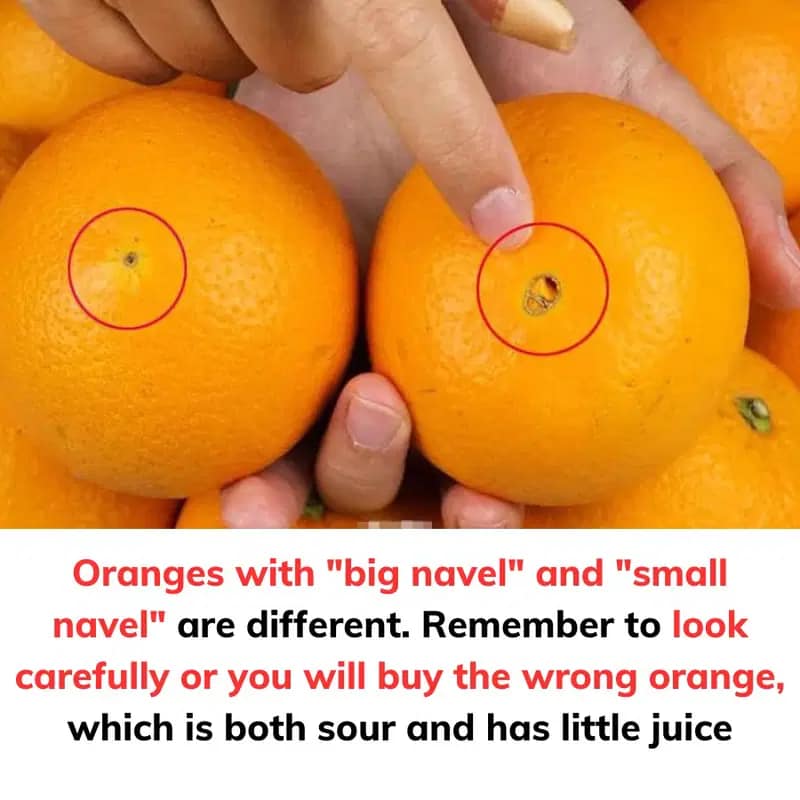Oranges are one of the most beloved fruits, known for their refreshing flavor, vibrant color, and versatility in both cooking and snacking. But while they might all look similar piled together in a grocery store bin, not every orange is created equal. Some are sweet, juicy, and full of flavor, while others fall flat—watery, bland, or disappointingly dry. So, how can you tell the difference before you even peel one open? The secret lies in a small, often-overlooked detail: the navel. That tiny indentation at the base of the fruit holds valuable clues about its taste, texture, and juiciness. With a little knowledge and a keen eye, you can confidently choose the best oranges every time you shop.

First, pay attention to the size of the navel. The navel is essentially a secondary fruit that grows inside the orange, and its size reveals a lot about the fruit’s development. Oranges with smaller navels tend to be sweeter because the sugar concentration remains more balanced during their growth. In contrast, larger navels often mean higher water content, which can dilute the sweetness and make the flavor less intense. The next time you’re choosing oranges, prioritize those with smaller, tighter navels—they’re far more likely to deliver that satisfying burst of citrus flavor.
Next, inspect the shape around the navel. The area surrounding the navel can tell you a lot about the fruit’s freshness and juice content. Ideally, it should feel firm, plump, and well-rounded. If the area appears sunken, wrinkled, or soft, it could indicate that the fruit is past its prime or has started to dry out from the inside. A round and taut area near the navel suggests that the orange is well-hydrated, fresh, and bursting with juice.
Weight is another key factor in selecting the perfect orange. Heavier oranges are juicier. When holding an orange, it should feel dense and substantial for its size. A lighter orange might look fine on the outside but could be disappointingly dry inside. Don’t hesitate to pick up a few oranges and compare their weight—it’s a simple but effective method for identifying fruit packed with juice.
The texture and color of the skin are equally important. A high-quality orange should have smooth, slightly glossy skin with a consistent, vibrant color. Pay particular attention to the area around the navel—it should look clean and free from blemishes, mold spots, or strange discolorations. While minor marks are natural and don’t always affect flavor, overly thick, puffy, or shriveled skin can signal dehydration or uneven ripening. The skin should also feel firm but not overly hard. Oranges with taut, bright skin are more likely to be fresh, juicy, and flavorful.
But why does the navel matter so much? The navel actually forms as a secondary fruit during the orange’s growth process. A smaller navel typically indicates a more balanced development, resulting in better sugar distribution and overall flavor. In contrast, larger navels can point to uneven ripening and excessive water absorption, which can dilute the natural sweetness of the fruit. Understanding this small but crucial detail can make a huge difference in your fruit selection process.
In addition to the navel, it’s also helpful to consider seasonality. Oranges are best when they are in season, as they reach peak sweetness and juiciness during this time. Navel oranges, for instance, are usually at their best from late fall to early spring. Buying oranges during their natural harvest season not only guarantees better flavor but also ensures a fresher product overall. Out-of-season oranges might still look decent on the outside but often lack the rich taste you’re looking for.
Another helpful trick is to use your nose. A ripe, flavorful orange will have a faint but noticeable citrus aroma, even through its skin. While this isn’t a foolproof method, it can provide an additional clue about the fruit’s flavor profile. If an orange smells fresh and citrusy, it’s likely to taste just as good.
Once you’ve chosen your oranges, store them properly to maintain their quality. If you plan to eat them within a few days, leaving them at room temperature is perfectly fine. However, if you want them to last longer, keep them in the refrigerator. Cold storage helps oranges retain their moisture and slows down the ripening process, preserving their freshness for up to two weeks.
So, the next time you find yourself in the produce section, surrounded by piles of bright, sun-colored oranges, don’t just grab the first one that catches your eye. Take a moment to inspect the navel, feel the weight, check the firmness of the surrounding area, and examine the skin. By paying attention to these small but significant details, you’ll drastically improve your odds of picking oranges that are sweet, juicy, and bursting with flavor.
In conclusion, selecting the perfect orange isn’t about luck—it’s about knowing what to look for. The navel, weight, skin texture, and aroma all work together to give you clues about the quality of the fruit. Armed with these tips, you’ll never have to settle for a bland or watery orange again. Instead, every slice, every sip of juice, and every zesty bite will be a delightful experience, full of the vibrant sweetness that makes oranges one of nature’s most cherished fruits.





